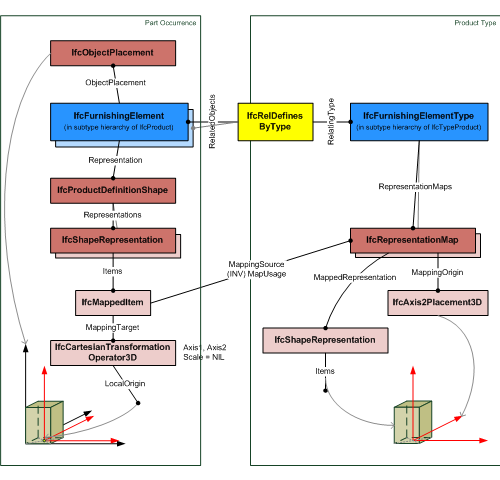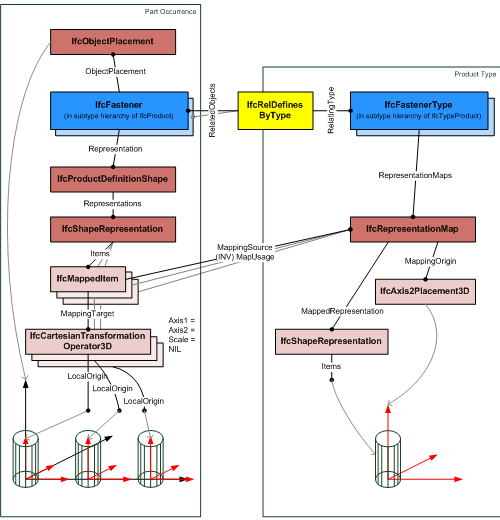6.6.3.3 IfcCourseType
6.6.3.3.1 Semantic definition
The IfcCourseType provides the type information for IfcCourse occurrences.
A course is a built element whose length greatly exceeds its thickness and often also its width, usually of a single material laid on site on top of another horizontal or nearly horizontal built element. A course is distinctive from a earthworks element in that a course is a graded granular (which can be bound or unbound) material that is generally processed in some fashion, where as earthworks elements are soil earthen based structure that can be formed by removal and transport of general ground material. Structurally a course does not have capacity to carry loads over open span, or to be removed or replaced as a single unit.
6.6.3.3.2 Entity inheritance
-
- IfcCourseType
- IfcBeamType
- IfcBearingType
- IfcBuildingElementProxyType
- IfcChimneyType
- IfcColumnType
- IfcCoveringType
- IfcCurtainWallType
- IfcDeepFoundationType
- IfcDoorType
- IfcFootingType
- IfcKerbType
- IfcMemberType
- IfcMooringDeviceType
- IfcNavigationElementType
- IfcPavementType
- IfcPlateType
- IfcRailType
- IfcRailingType
- IfcRampFlightType
- IfcRampType
- IfcRoofType
- IfcShadingDeviceType
- IfcSlabType
- IfcStairFlightType
- IfcStairType
- IfcTrackElementType
- IfcWallType
- IfcWindowType
6.6.3.3.3 Attributes
| # | Attribute | Type | Description |
|---|---|---|---|
| IfcRoot (4) | |||
| 1 | GlobalId | IfcGloballyUniqueId |
Assignment of a globally unique identifier within the entire software world. |
| 2 | OwnerHistory | OPTIONAL IfcOwnerHistory |
Assignment of the information about the current ownership of that object, including owning actor, application, local identification and information captured about the recent changes of the object. |
| 3 | Name | OPTIONAL IfcLabel |
An optional name for use by the participating software systems or users. For some subtypes of IfcRoot the insertion of the Name attribute may be required. This would be enforced by a where rule. |
| 4 | Description | OPTIONAL IfcText |
An optional description, provided to exchange informative comments. |
| IfcObjectDefinition (7) | |||
| HasAssignments | SET [0:?] OF IfcRelAssigns FOR RelatedObjects |
Reference to the relationship objects, that assign (by an association relationship) other subtypes of IfcObject to this object instance. Examples are the association to products, processes, controls, resources or groups. |
|
| Nests | SET [0:1] OF IfcRelNests FOR RelatedObjects |
References to the decomposition relationship being a nesting. It determines that this object definition is a part within an ordered whole/part decomposition relationship. An object occurrence or type can only be part of a single decomposition (to allow hierarchical structures only). |
|
| IsNestedBy | SET [0:?] OF IfcRelNests FOR RelatingObject |
References to the decomposition relationship being a nesting. It determines that this object definition is the whole within an ordered whole/part decomposition relationship. An object or object type can be nested by several other objects (occurrences or types). |
|
| HasContext | SET [0:1] OF IfcRelDeclares FOR RelatedDefinitions |
References to the context providing context information such as project unit or representation context. It should only be asserted for the uppermost non-spatial object. |
|
| IsDecomposedBy | SET [0:?] OF IfcRelAggregates FOR RelatingObject |
References to the decomposition relationship being an aggregation. It determines that this object definition is the whole within an unordered whole/part decomposition relationship. An object definition can be aggregated by several other objects (occurrences or parts). |
|
| Decomposes | SET [0:1] OF IfcRelAggregates FOR RelatedObjects |
References to the decomposition relationship being an aggregation. It determines that this object definition is a part within an unordered whole/part decomposition relationship. An object definition can only be part of a single decomposition (to allow hierarchical structures only). |
|
| HasAssociations | SET [0:?] OF IfcRelAssociates FOR RelatedObjects |
Reference to the relationship objects, that associates external references or other resource definitions to the object. Examples are the association to library, documentation or classification. |
|
| IfcTypeObject (3) | |||
| 5 | ApplicableOccurrence | OPTIONAL IfcIdentifier |
The attribute optionally defines the data type of the occurrence object, to which the assigned type object can relate. If not present, no restriction is given regarding which occurrence object the type object is applicable to. The following conventions are used:
|
| 6 | HasPropertySets | OPTIONAL SET [1:?] OF IfcPropertySetDefinition |
Set of unique property sets that are associated with the object type and are common to all object occurrences referring to this object type. |
| Types | SET [0:1] OF IfcRelDefinesByType FOR RelatingType |
Reference to the relationship IfcRelDefinesByType and thus to those occurrence objects, which are defined by this type. |
|
| IfcTypeProduct (3) | |||
| 7 | RepresentationMaps | OPTIONAL LIST [1:?] OF UNIQUE IfcRepresentationMap |
List of unique representation maps. Each representation map describes a block definition of the shape of the product style. By providing more than one representation map, a multi-view block definition can be given. |
| 8 | Tag | OPTIONAL IfcLabel |
The tag (or label) identifier at the particular type of a product, e.g. the article number (like the EAN). It is the identifier at the specific level. |
| ReferencedBy | SET [0:?] OF IfcRelAssignsToProduct FOR RelatingProduct |
Reference to the IfcRelAssignsToProduct relationship, by which other products, processes, controls, resources or actors (as subtypes of IfcObjectDefinition) can be related to this product type. |
|
| IfcElementType (1) | |||
| 9 | ElementType | OPTIONAL IfcLabel |
The type denotes a particular type that indicates the object further. The use has to be established at the level of instantiable subtypes. In particular it holds the user defined type, if the enumeration of the attribute 'PredefinedType' is set to USERDEFINED. |
| Click to show 18 hidden inherited attributes Click to hide 18 inherited attributes | |||
| IfcCourseType (1) | |||
| 10 | PredefinedType | IfcCourseTypeEnum |
Identifies the predefined types of a course element. This type may associate additional specific property sets. |
6.6.3.3.4 Formal propositions
| Name | Description |
|---|---|
| CorrectPredefinedType |
The inherited attribute ElementType shall be provided, if the PredefinedType is set to USERDEFINED. |
|
|
6.6.3.3.5 Property sets
-
Pset_BoundedCourseCommon
- SpreadingRate
-
Pset_Condition
- AssessmentDate
- AssessmentCondition
- AssessmentDescription
- AssessmentType
- AssessmentMethod
- LastAssessmentReport
- NextAssessmentDate
- AssessmentFrequency
-
Pset_ConstructionAdministration
- ProcurementMethod
- SpecificationSectionNumber
- SubmittalIdentifer
-
Pset_CourseApplicationConditions
- ApplicationTemperature
- WeatherConditions
-
Pset_CourseCommon
- NominalLength
- NominalThickness
- NominalWidth
-
Pset_ElementKinematics
- CyclicPath
- CyclicRange
- LinearPath
- LinearRange
- MaximumAngularVelocity
- MaximumConstantSpeed
- MinimumTime
-
Pset_EnvironmentalCondition
- ReferenceAirRelativeHumidity
- ReferenceEnvironmentTemperature
- MaximumAtmosphericPressure
- StorageTemperatureRange
- MaximumWindSpeed
- OperationalTemperatureRange
- MaximumRainIntensity
- SaltMistLevel
- SeismicResistance
- SmokeLevel
- MaximumSolarRadiation
-
Pset_EnvironmentalImpactIndicators
- Reference
- FunctionalUnitReference
- IndicatorsUnit
- LifeCyclePhase
- ExpectedServiceLife
- TotalPrimaryEnergyConsumptionPerUnit
- WaterConsumptionPerUnit
- HazardousWastePerUnit
- NonHazardousWastePerUnit
- ClimateChangePerUnit
- AtmosphericAcidificationPerUnit
- RenewableEnergyConsumptionPerUnit
- NonRenewableEnergyConsumptionPerUnit
- ResourceDepletionPerUnit
- InertWastePerUnit
- RadioactiveWastePerUnit
- StratosphericOzoneLayerDestructionPerUnit
- PhotochemicalOzoneFormationPerUnit
- EutrophicationPerUnit
-
Pset_EnvironmentalImpactValues
- TotalPrimaryEnergyConsumption
- WaterConsumption
- HazardousWaste
- NonHazardousWaste
- ClimateChange
- AtmosphericAcidification
- RenewableEnergyConsumption
- NonRenewableEnergyConsumption
- ResourceDepletion
- InertWaste
- RadioactiveWaste
- StratosphericOzoneLayerDestruction
- PhotochemicalOzoneFormation
- Eutrophication
- LeadInTime
- Duration
- LeadOutTime
-
Pset_MaintenanceStrategy
- AssetCriticality
- AssetFrailty
- AssetPriority
- MonitoringType
- AccidentResponse
-
Pset_MaintenanceTriggerCondition
- ConditionTargetPerformance
- ConditionMaintenanceLevel
- ConditionReplacementLevel
- ConditionDisposalLevel
-
Pset_MaintenanceTriggerDuration
- DurationTargetPerformance
- DurationMaintenanceLevel
- DurationReplacementLevel
- DurationDisposalLevel
-
Pset_MaintenanceTriggerPerformance
- TargetPerformance
- PerformanceMaintenanceLevel
- ReplacementLevel
- DisposalLevel
-
Pset_ManufacturerTypeInformation
- GlobalTradeItemNumber
- ArticleNumber
- ModelReference
- ModelLabel
- Manufacturer
- ProductionYear
- AssemblyPlace
- OperationalDocument
- SafetyDocument
- PerformanceCertificate
-
Pset_Risk
- RiskName
- RiskType
- NatureOfRisk
- RiskAssessmentMethodology
- UnmitigatedRiskLikelihood
- UnmitigatedRiskConsequence
- UnmitigatedRiskSignificance
- MitigationPlanned
- MitigatedRiskLikelihood
- MitigatedRiskConsequence
- MitigatedRiskSignificance
- MitigationProposed
- AssociatedProduct
- AssociatedActivity
- AssociatedLocation
-
Pset_ServiceLife
- ServiceLifeDuration
- MeanTimeBetweenFailure
-
Pset_Tolerance
- ToleranceDescription
- ToleranceBasis
- OverallTolerance
- HorizontalTolerance
- OrthogonalTolerance
- VerticalTolerance
- PlanarFlatness
- HorizontalFlatness
- ElevationalFlatness
- SideFlatness
- OverallOrthogonality
- HorizontalOrthogonality
- OrthogonalOrthogonality
- VerticalOrthogonality
- OverallStraightness
- HorizontalStraightness
- OrthogonalStraightness
- VerticalStraightness
-
Pset_Uncertainty
- UncertaintyBasis
- UncertaintyDescription
- HorizontalUncertainty
- LinearUncertainty
- OrthogonalUncertainty
- VerticalUncertainty
-
Pset_Warranty
- WarrantyIdentifier
- WarrantyStartDate
- IsExtendedWarranty
- WarrantyPeriod
- WarrantyContent
- PointOfContact
- Exclusions
-
Qto_CourseBaseQuantities
- Length
- Width
- Thickness
- Volume
- GrossVolume
- Weight
6.6.3.3.6 Concept usage
| Concept | Usage | Description | |
|---|---|---|---|
| IfcRoot (2) | |||
| Revision Control | General |
Ownership, history, and merge state is captured using IfcOwnerHistory. |
|
| Software Identity | General |
IfcRoot assigns the globally unique ID. In addition, it may also provide a name and description for the concept. |
|
| IfcObjectDefinition (9) | |||
| Classification Association | General |
Any object occurrence or object type can have a reference to a specific classification reference, i.e. to a particular facet within a classification system. |
|
| Aggregation | General |
No description available. |
|
| Approval Association | General |
No description available. |
|
| Constraint Association | General |
No description available. |
|
| Document Association | General |
No description available. |
|
| Library Association | General |
No description available. |
|
| Material Association | General |
No description available. |
|
| Material Single | General |
No description available. |
|
| Nesting | General |
No description available. |
|
| IfcTypeObject (2) | |||
| Object Type Predefined Type | General |
No description available. |
|
| Property Sets for Types | General |
No description available. |
|
| IfcTypeProduct (7) | |||
| Product Type Shape | General |
The RepresentationMaps define the type product shape and multiple geometric representations can be assigned. If a product occurrence is assigned to the type by using the IfcRelDefinesByType relationship, then these occurrences have to reference the representation maps. The reference is created by one or multiple IfcShapeRepresentation's having an IfcMappedItem as Items, that places the IfcRepresentationMap of the type product into the spatial contexts, i.e. by using a Cartesian transformation operator to transform the IfcRepresentationMap into the object coordinate system of the product occurrence. Figure 6.6.3.3.A illustrates an example of referencing a representation map by the shape representation of a product occurrence. Here the Cartesian transformation operator only uses translation, but no rotation, mirroring, or scaling.  Figure 6.6.3.3.B illustrates an example of referencing a representation multiple times by the shape representation of a product occurrence. Here the Cartesian transformation operator only uses translation, but no rotation, mirroring, or scaling. The different translation values determine the pattern of the multiple placement.  |
|
| Product Type Geometric Representation | General |
No description available. |
|
| Property Sets for Objects | General |
This concept can be applied to the following resources: |
|
| Type Body AdvancedBrep Geometry | General |
No description available. |
|
| Type Body Brep Geometry | General |
No description available. |
|
| Type Body CSG Geometry | General |
No description available. |
|
| Type Body Geometry | General |
No description available. |
|
| IfcElementType (5) | |||
| Element Type Predefined Type | General |
No description available. |
|
| Type Body Tessellated Geometry | General |
No description available. |
|
| Type Element Aggregation | General |
No description available. |
|
| Property Sets for Objects | General |
This concept can be applied to the following resources:
|
|
| Type Element Nesting | General |
No description available. |
|
| Click to show 25 hidden inherited concepts Click to hide 25 inherited concepts | |||
| IfcCourseType (2) | |||
| Property Sets for Objects | General |
This concept can be applied to the following resources: |
|
| Quantity Sets | General |
This concept can be applied to the following resources: |
|
6.6.3.3.7 Formal representation
ENTITY IfcCourseType
SUBTYPE OF (IfcBuiltElementType);
PredefinedType : IfcCourseTypeEnum;
WHERE
CorrectPredefinedType : (PredefinedType <> IfcCourseTypeEnum.USERDEFINED) OR
((PredefinedType = IfcCourseTypeEnum.USERDEFINED) AND EXISTS (SELF\IfcElementType.ElementType));
END_ENTITY;